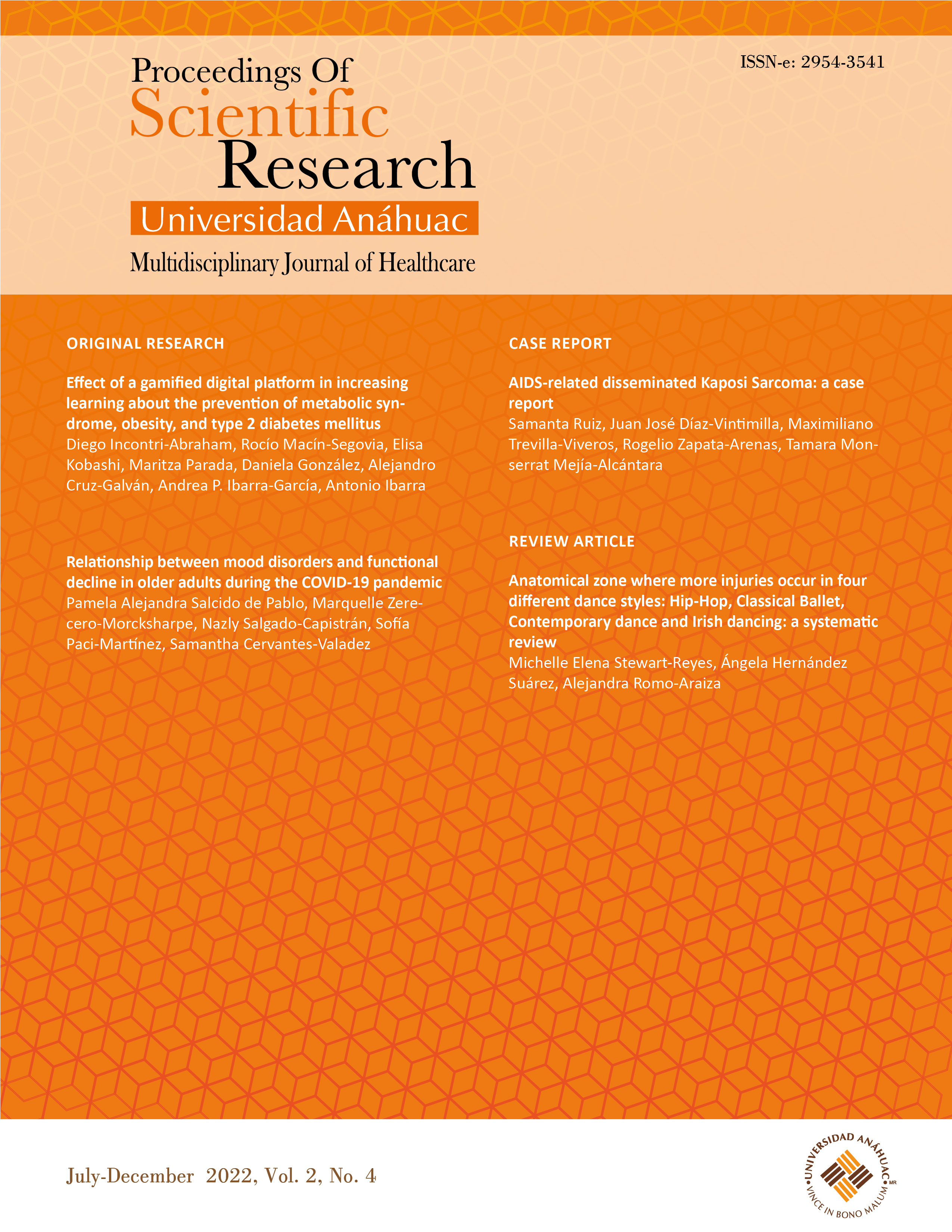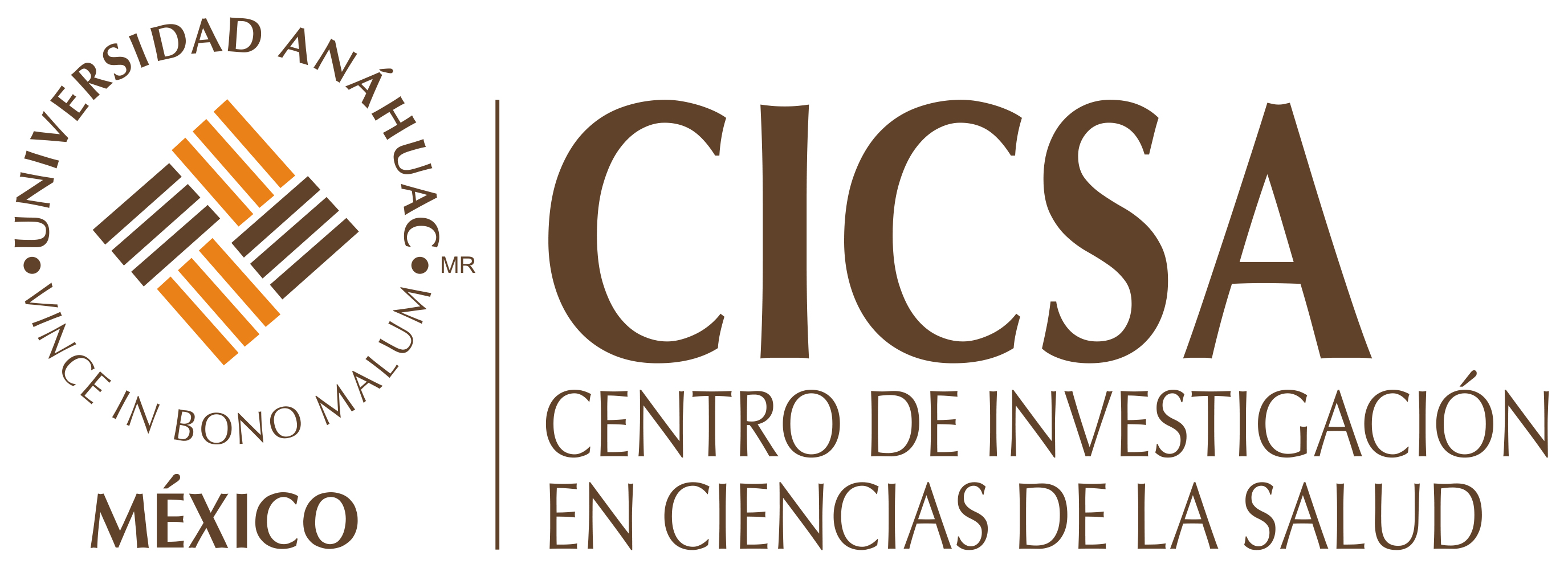Anatomical zone where more injuries occur in four different dance styles: Hip-Hop, Classical Ballet, Contemporary dance and Irish dancing: a systematic review.
DOI:
https://doi.org/10.36105/psrua.2022v2n4.04Palabras clave:
lesión, bailarines, incidenciaResumen
Introducción: Actualmente no existe una revisión sistemática cuyo enfoque sea identificar qué zona anatómica tiene mayor incidencia a lesiones al practicar cuatro estilos diferentes de danza: hip-hop, ballet clásico, danza contemporánea y danza irlandesa. Objetivo: Determinar y resumir la incidencia de lesiones por zonas anatómicas en bailarines semi-profesionales y profesionales que practican alguno de los siguientes estilos de danza: ballet, danza contemporánea, hip-hop y danza irlandesa. Métodos: Los artículos se seleccionaron de acuerdo con los siguientes criterios: año de publicación (entre 2016 y 2022), estudios observacionales de cohorte en idioma inglés, texto completo disponible y análisis de la zona anatómica con mayor incidencia a lesiones en uno de los cuatro estilos de danza mencionados anteriormente. Los términos MESH y operadores booleanos utilizados para la búsqueda fueron, “lesiones Y bailarines Y incidencia”. Fuentes de información: Proquest, Pubmed, Google Scholar, Elsevier, Clinical Key, ScienceDirect. Resultados: Un total de 511 artículos fueron identificados, de los cuales solo 19 fueron incluidos en el análisis. El resultado de la literatura analizada reveló que el tobillo es la zona anatómica con mayor incidencia de lesión (62.9%), las lesiones crónicas y de sobreuso presentan una mayor tasa de incidencia (63%) y el tipo de lesión musculoesquelética más común es el del ligamento/articulación (36.84%). Conclusión: La extremidad inferior tuvo la mayor tasa de incidencia de lesiones. A pesar de que los cuatro estilos de danza seleccionados tienen una técnica y una biomecánica distinta, la zona anatómica que reporta mayor incidencia a sufrir una lesión es el tobillo.
Descargas
Referencias
Vassallo AJ, Trevor BL, Mota L, Pappas E, Hiller CE. Injury rates and characteristics in recreational, elite student and professional dancers: A systematic review. J Sports Sci [Internet]. 2019;37(10):1113-22. Available from: http://doi.org/10.1080/02640414.2018.1544538
Faulkner E. Choreography-specific cross-training and conditioning programs. Phys Med Rehabil Clin N Am. 2021;32(1):103-15. https://doi.org/10.1016/j.pmr.2020.09.003
Steinberg N, Siev-Ner I, Peleg S, Dar G, Masharawi Y, Zeev A, et al. Injury patterns in young, non-professional dancers. J Sports Sci. 2011;29(1):47-54. https://doi.org/10.1080/02640414.2010.521167
Gamboa JM, Roberts LA, Maring J, Fergus A. Injury patterns in elite preprofessional ballet dancers and the utility of screening programs to identify risk characteristics. J Orthop Sports Phys Ther. 2008;38(3):126–36. https://www.jospt.org/doi/10.2519/jospt.2008.2390
Moita JP, Nunes A, Esteves J, Oliveira R, Xarez L. The relationship between muscular strength and dance injuries: A systematic review. Med Probl Perform Art. 2017;32(1):40-50. https://doi.org/10.21091/mppa.2017.1002
Smith TO, Davies L, de Medici A, Hakim A, Haddad F, Macgregor A. Prevalence and profile of musculoskeletal injuries in ballet dancers: A systematic review and meta-analysis. Phys Ther Sport. 2016;19:50-6. https://doi.org/10.1016/j.ptsp.2015.12.007
Lee L, Reid D, Cadwell J, et al. Injury incidence, dance exposure and the use of movement competency screen (MCS) to identify variables associated with injury in full time pre-professional dancers. In J Sports Phys Ther. 2017;12(3):271-5.
Mailuhu AKE, van Rijn RM, Stubbe JH, Bierma-Zeinstra SMA, van Middelkoop M. Incidence and prediction of ankle injury risk: a prospective cohort study on 91 contemporary preprofessional dancers. BMJ Open Sport Exerc Med. 2021. http://doi.org/10.1136/bmjsem-2021-001060
Bronner S, Bauer NG. Risk factors for musculoskeletal injury in elite pre-professional modern dancers: A prospective cohort prognostic study. Phys Ther Sport [Internet]. 2018;31:42-51. Available from: https://doi.org/10.1016/j.ptsp.2018.01.008
McBride C, Bronner S. Injury characteristics in professional modern dancers: A 15-year analysis of work-related injury rates and patterns. J Sports Sci. 2022;40(7):821–37. https://doi.org/10.12678/1089-313X.061521g
Cahalan R, Kearney P, Ni Bhriain O, Redding E, Quin E, McLaughlin LC, et al. Dance exposure, wellbeing and injury in collegiate Irish and contemporary dancers: A prospective study. Phys Ther Sport. 2018;34:77-83. https://doi.org/10.1016/j.ptsp.2018.09.006
Cahalan R, Bargary N, O’Sullivan K. Pain and injury in elite adolescent Irish dancers: A cross-sectional study. J Dance Med Sci. 2018;22(2):91-9. https://doi.org/10.12678/1089-313X.22.2.91
Cahalan R, Bargary N, O’Sullivan K. Dance exposure, general health, sleep and injury in elite adolescent Irish dancers: A prospective study. Phys Ther Sport. 2019. https://doi.org/10.1016/j.ptsp.2019.09.008
Fuller M, Moyle GM, Minett GM. Injuries across a pre-professional ballet and contemporary dance tertiary training program: A retrospective cohort study. J Sci Med Sport. 2020;23(12):1166-71. https://doi.org/10.1016/j.jsams.2020.06.012
Jeffries AC, Wallace L, Coutts AJ, Cohen AM, McCall A, Impellizzeri FM. Injury, illness, and training load in a professional contemporary dance company: A prospective study. J Athl Train. 2020;55(9):967-76.
http://doi.org/10.4085/1062-6050-477-19
Jubb C, Bell L, Cimelli S, Wolman R. Injury patterns in hip hop dancers. J Dance Med Sci. 2019;23(4):145-9. https://doi.org/10.12678/1089-313X.23.4.145
Kenny SJ, Critchley ML, Whittaker JL, Kodalore Vijayan VW, Emery CA. Association between pre-participation characteristics and risk of injury amongst pre-professional dancers. Phys Ther Sport. 2021;52:239-47. https://doi.org/10.1016/j.ptsp.2021.10.003
Lee L, Reid D, Cadwell J, Palmer P. Injury incidence, dance exposure and the use of the movement competency screen (mcs) to identify variables associated with injury in full-time pre-professional dancers. Int J Sports Phys Ther. 2017;12(3):352-70.
Mattiussi AM, Shaw JW, Williams S, Price PD, Brown DD, Cohen DD, et al. Injury epidemiology in professional ballet: a five-season prospective study of 1596 medical attention injuries and 543 time-loss injuries. Br J Sports Med. 2021;55(15):843-50. http://doi.org/10.1136/bjsports-2020-103817
Novosel B, Sekulic D, Peric M, Kondric M, Zaletel P. Injury occurrence and return to dance in professional ballet: Prospective analysis of specific correlates. Int J Environ Res Public Health [Internet]. 2019;16(5):765. [cited 2022 June 13]. Available from: http://doi.org/10.3390/ijerph16050765
Huang PY, Lin CW, Jankaew A, Lin CF. Relationship of extrinsic risk factors to lower extremity injury in collegiate ballet dancers. Front Bioeng Biotechnol [Internet]. 2022;10:878448. [cited 2022 June 13]. Available from: http://doi.org/10.3389/fbioe.2022.878448
Tjukov O, Engeroff T, Vogt L, Banzer W, Niederer D. Injury profile of hip-hop dancers. J Dance Med Sci. 2020;24(2):66-72. https://doi.org/10.12678/1089-313X.24.2.66
Tsiouti N, Wyon M. Injury occurrence in break Dance. An online cross-sectional cohort study of breakers. J Dance Med Sci. 2021;25(1):2-8. http://doi.org/10.12678/1089-313X.031521a
Ursej E, Sekulic D, Prus D, Gabrilo G, Zaletel P. Investigating the prevalence and predictors of injury occurrence in competitive hip hop dancers: Prospective analysis. Int J Environ Res Public Health. 2019;16(17):3214. http://doi.org/10.3390/ijerph16173214
Van Seters C, van Rijn RM, van Middelkoop M, Stubbe JH. Risk factors for lower-extremity injuries among contemporary dance students. Clin J Sport Med. 2017;30(1). http://doi.org/10.1097/JSM.0000000000000533
Van Winden DPAM, Van Rijn RM, Richardson A, Savelsbergh GJP, Oudejans RRD, Stubbe JH. Detailed injury epidemiology in contemporary dance: a 1-year prospective study of 134 students. BMJ Open Sport Exerc Med. 2019;5(1):e000453. http://doi.org/10.1136/bmjsem-2018-000453
Aicale R, Tarantino D, Maffulli N. Overuse injuries in sport: a comprehensive overview. J Orthop Surg Res. (2018);13:309 https://doi.org/10.1186/s13018-018-1017-5
Russell JA. Preventing dance injuries: current perspectives. Open Access J Sports Med [Internet]. 2013;4:199-210. [cited 2022 June 13]. Available from: http://doi.org/10.2147/OAJSM.S36529
Li F, Adrien N, He Y. Biomechanical risks associated with foot and ankle injuries in ballet dancers: A systematic review. Int J Environ Res Public Health. 2022;19(8):4916. https://doi.org/10.3390/ijerph19084916
Page MJ, McKenzie JE, Bossuyt PM, Boutron I, Hoffmann TC, Mulrow CD, et al. The PRISMA 2020 statement: an updated guideline for reporting systematic reviews. BJM. 2021;372:n71. http://doi.org/10.1136/bmj.n71
Page MJ, McKenzie JE, Bossuyt PM, Boutron I, Hoffmann TC, Mulrow CD, et al. The PRISMA 2020 statement: an updated guideline for reporting systematic reviews. J. Clin. Epidemiol. 2021.
Page MJ, McKenzie JE, Bossuyt PM, Boutron I, Hoffmann TC, Mulrow CD, et al. The PRISMA 2020 statement: an updated guideline for reporting systematic reviews. Syst Rev. 2021;10:89. https://doi.org/10.1186/s13643-021-01626-4
Downed JM, Brennan LM, Williams CH, Dean SR. Development of critical appraisal tool to asses the quality of cross-sectional studies (AXIS). BMJ Open. [Internet]. 2016;8. [cited 2022 July 12]. Available from: https://doi.org/10.1136/bmjopen-2016-011458
Descargas
Publicado
Número
Sección
Licencia
Derechos de autor 2022 Michelle Elena Stewart-Reyes, Ángela Hernández Suárez, Alejandra Romo-Araiza

Esta obra está bajo una licencia internacional Creative Commons Atribución-NoComercial-SinDerivadas 4.0.
Todo el contenido intelectual que se encuentra en la presente publicación periódica se licencia al público consumidor bajo la figura de Creative Commons©, salvo que el autor de dicho contenido hubiere pactado en contrario o limitado dicha facultad a “Proceedings of Scientific Research Universidad Anáhuac. Multidisciplinary Journal of Healthcare©” o “Universidad Anáhuac México©” por escrito y expresamente.
Proceedings of Scientific Research Universidad Anáhuac. Multidisciplinary Journal of Healthcare se distribuye bajo una Licencia Creative Commons Reconocimiento-No comercial-Sin derivados 4.0 Internacional (CC BY-NC-ND 4.0).
El autor conserva los derechos patrimoniales sin restricciones y garantiza a la revista el derecho de ser la primera publicación del trabajo. El autor es libre de publicar en cualquier otro medio su artículo, como un repositorio institucional.















